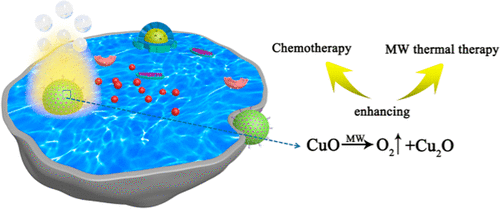Our official English website, www.x-mol.net, welcomes your
feedback! (Note: you will need to create a separate account there.)
Oxygen Production of Modified Core–Shell [email protected]2 Nanocomposites by Microwave Radiation to Alleviate Cancer Hypoxia for Enhanced Chemo-Microwave Thermal Therapy
ACS Nano ( IF 15.8 ) Pub Date : 2018-12-04 00:00:00 , DOI: 10.1021/acsnano.8b07749 Zengzhen Chen 1, 2 , Meng Niu 3 , Gen Chen 4 , Qiong Wu 1 , Longfei Tan 1 , Changhui Fu 1 , Xiangling Ren 1 , Hongshan Zhong 3 , Ke Xu 3 , Xianwei Meng 1
ACS Nano ( IF 15.8 ) Pub Date : 2018-12-04 00:00:00 , DOI: 10.1021/acsnano.8b07749 Zengzhen Chen 1, 2 , Meng Niu 3 , Gen Chen 4 , Qiong Wu 1 , Longfei Tan 1 , Changhui Fu 1 , Xiangling Ren 1 , Hongshan Zhong 3 , Ke Xu 3 , Xianwei Meng 1
Affiliation

|
There are acknowledged risks of metastasis of cancer cells and obstructing cancer treatment from hypoxia. In this work, we design a multifunctional nanocomposite for treating hypoxia based on the oxygen release capability of CuO triggered by microwave (MW). Core–shell [email protected]2 nanocomposites are prepared by confining CuO nanoparticles within the cavities of mesoporous ZrO2 hollow nanospheres. 1-Butyl-3-methylimidazolium hexafluorophosphate (IL) is loaded to the [email protected]2 nanocomposites for improving microwave thermal therapy (MWTT). 1-Tetradecanol (PCM) is introduced to regulate the release of chemotherapeutic drugs of doxorubicin (DOX). Thus, the [email protected]2 multifunctional ([email protected]) nanocomposites are obtained. Finally, [email protected] nanocomposites are modified by monomethoxy polyethylene glycol sulfhydryl (mPEG-SH, 5 kDa) ([email protected] nanocomposites). [email protected] nanocomposites can produce oxygen in the tumor microenvironment during the course of tumor treatment, thereby alleviating the hypoxic state and improving the therapeutic effect. In vivo antitumor experiments demonstrate a very high tumor inhibition rate of 92.14%. In addition, computed tomography (CT) imaging contrast of the nanocomposites can be enhanced due to the high atomic number of Zr. Therefore, [email protected] nanocomposites can be applied for monitoring the tumor-treatment process in real time. This combined therapy offers many opportunities, such as the production of oxygen from CuO nanoparticles by MW to alleviate hypoxia, the enhancement of combined treatment of MWTT and chemotherapy, and the potential application of CT imaging to visualize the treatment process, which therefore provides a promising method for the clinical treatment of tumors in the future.
中文翻译:

微波辐射制氧-修饰的核-壳[电子邮件保护] 2纳米复合材料,以减轻癌症缺氧,增强化学-微波热疗法的作用
存在公认的转移癌细胞的风险,并阻碍了缺氧引起的癌症治疗。在这项工作中,我们基于微波(MW)触发的CuO的释氧能力,设计了一种用于治疗缺氧的多功能纳米复合材料。通过将CuO纳米颗粒限制在介孔ZrO 2空心纳米球的腔体内,制备核-壳[受电子邮件保护的] 2纳米复合材料。将1-丁基-3-甲基咪唑六氟磷酸盐(IL)装入[受电子邮件保护的] 2纳米复合材料中,以改善微波热疗(MWTT)。引入1-四氢松香酚(PCM)来调节阿霉素(DOX)化疗药物的释放。因此,[电子邮件保护] 2获得了多功能([受电子邮件保护])纳米复合材料。最后,用单甲氧基聚乙二醇巯基(mPEG-SH,5 kDa)([电子邮件保护]纳米复合材料)修饰[电子邮件保护]纳米复合材料。受电子邮件保护的纳米复合材料可在肿瘤治疗过程中在肿瘤微环境中产生氧气,从而缓解低氧状态并提高治疗效果。体内抗肿瘤实验显示出非常高的肿瘤抑制率,为92.14%。此外,由于高Zr原子数,可以增强纳米复合材料的计算机断层扫描(CT)成像对比度。因此,[受电子邮件保护的]纳米复合材料可用于实时监测肿瘤的治疗过程。这种联合疗法提供了许多机会,例如通过MW从CuO纳米颗粒中生产氧气以缓解缺氧,增强MWTT和化学疗法的联合治疗以及CT成像在治疗过程中可视化的潜在应用,因此提供了广阔的前景未来临床治疗肿瘤的方法。
更新日期:2018-12-04
中文翻译:

微波辐射制氧-修饰的核-壳[电子邮件保护] 2纳米复合材料,以减轻癌症缺氧,增强化学-微波热疗法的作用
存在公认的转移癌细胞的风险,并阻碍了缺氧引起的癌症治疗。在这项工作中,我们基于微波(MW)触发的CuO的释氧能力,设计了一种用于治疗缺氧的多功能纳米复合材料。通过将CuO纳米颗粒限制在介孔ZrO 2空心纳米球的腔体内,制备核-壳[受电子邮件保护的] 2纳米复合材料。将1-丁基-3-甲基咪唑六氟磷酸盐(IL)装入[受电子邮件保护的] 2纳米复合材料中,以改善微波热疗(MWTT)。引入1-四氢松香酚(PCM)来调节阿霉素(DOX)化疗药物的释放。因此,[电子邮件保护] 2获得了多功能([受电子邮件保护])纳米复合材料。最后,用单甲氧基聚乙二醇巯基(mPEG-SH,5 kDa)([电子邮件保护]纳米复合材料)修饰[电子邮件保护]纳米复合材料。受电子邮件保护的纳米复合材料可在肿瘤治疗过程中在肿瘤微环境中产生氧气,从而缓解低氧状态并提高治疗效果。体内抗肿瘤实验显示出非常高的肿瘤抑制率,为92.14%。此外,由于高Zr原子数,可以增强纳米复合材料的计算机断层扫描(CT)成像对比度。因此,[受电子邮件保护的]纳米复合材料可用于实时监测肿瘤的治疗过程。这种联合疗法提供了许多机会,例如通过MW从CuO纳米颗粒中生产氧气以缓解缺氧,增强MWTT和化学疗法的联合治疗以及CT成像在治疗过程中可视化的潜在应用,因此提供了广阔的前景未来临床治疗肿瘤的方法。










































 京公网安备 11010802027423号
京公网安备 11010802027423号